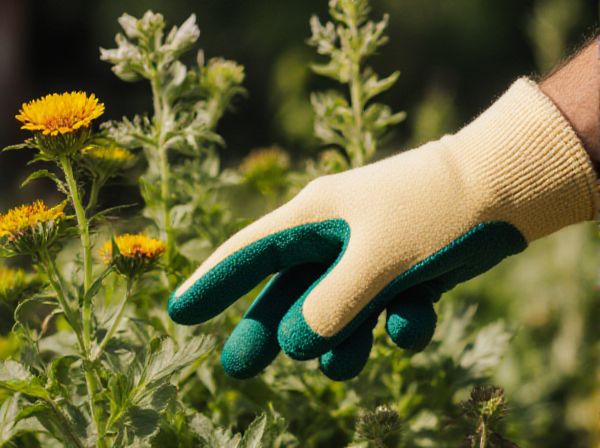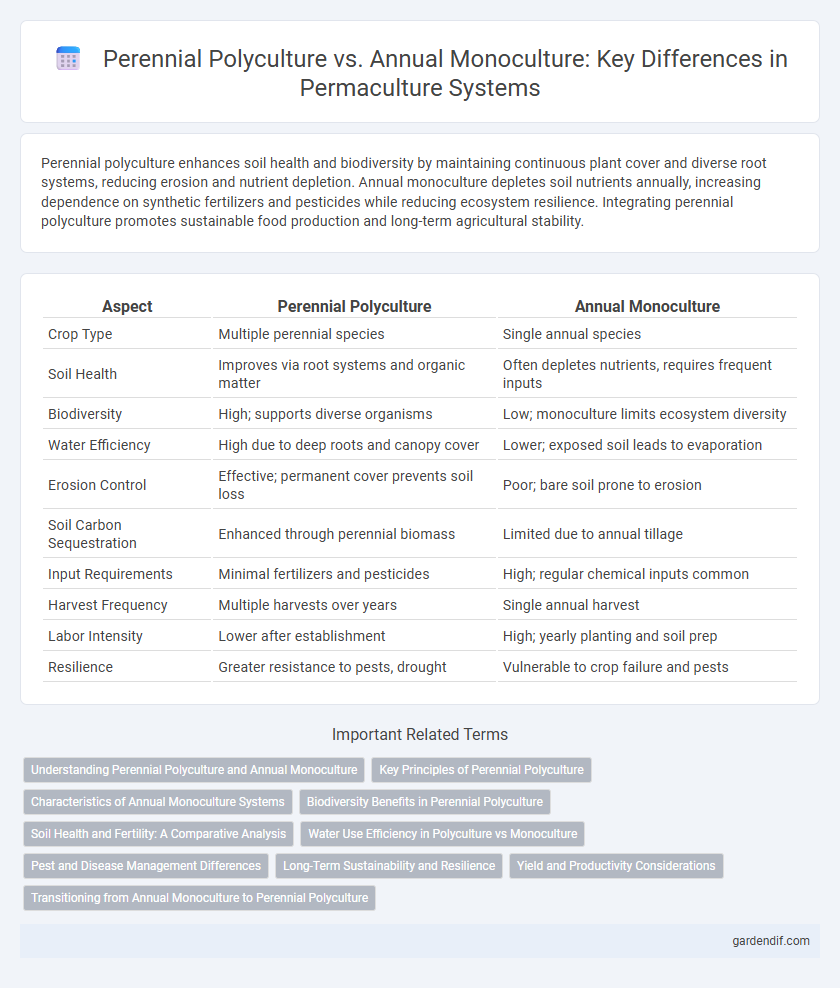
perennial polyculture vs annual monoculture Illustration
Perennial polyculture enhances soil health and biodiversity by maintaining continuous plant cover and diverse root systems, reducing erosion and nutrient depletion. Annual monoculture depletes soil nutrients annually, increasing dependence on synthetic fertilizers and pesticides while reducing ecosystem resilience. Integrating perennial polyculture promotes sustainable food production and long-term agricultural stability.
Table of Comparison
| Aspect | Perennial Polyculture | Annual Monoculture |
|---|---|---|
| Crop Type | Multiple perennial species | Single annual species |
| Soil Health | Improves via root systems and organic matter | Often depletes nutrients, requires frequent inputs |
| Biodiversity | High; supports diverse organisms | Low; monoculture limits ecosystem diversity |
| Water Efficiency | High due to deep roots and canopy cover | Lower; exposed soil leads to evaporation |
| Erosion Control | Effective; permanent cover prevents soil loss | Poor; bare soil prone to erosion |
| Soil Carbon Sequestration | Enhanced through perennial biomass | Limited due to annual tillage |
| Input Requirements | Minimal fertilizers and pesticides | High; regular chemical inputs common |
| Harvest Frequency | Multiple harvests over years | Single annual harvest |
| Labor Intensity | Lower after establishment | High; yearly planting and soil prep |
| Resilience | Greater resistance to pests, drought | Vulnerable to crop failure and pests |
Understanding Perennial Polyculture and Annual Monoculture
Perennial polyculture integrates diverse, long-lived plant species that improve soil health, increase biodiversity, and enhance ecosystem resilience over time. Annual monoculture relies on planting a single crop each season, often resulting in soil degradation, increased pest vulnerability, and higher input requirements. Understanding these contrasting approaches reveals perennial polyculture's advantages in sustainability and productivity compared to the intensive resource demands of annual monoculture.
Key Principles of Perennial Polyculture
Perennial polyculture emphasizes biodiversity, soil health, and resource efficiency by cultivating multiple perennial species together, which reduces erosion and enhances nutrient cycling. Key principles include selecting complementary plants that support each other's growth, fostering natural pest control, and maintaining continuous ground cover to protect and enrich the soil. This approach contrasts with annual monoculture's repetitive planting and soil disturbance, promoting long-term ecosystem resilience and sustainable food production.
Characteristics of Annual Monoculture Systems
Annual monoculture systems are characterized by the repeated cultivation of a single crop species within a single growing season, often leading to soil nutrient depletion and increased vulnerability to pests and diseases. This farming approach relies heavily on synthetic fertilizers, pesticides, and intensive tillage, which can degrade soil structure and reduce biodiversity over time. High input costs and environmental impacts make annual monocultures less sustainable compared to diversified perennial polyculture systems.
Biodiversity Benefits in Perennial Polyculture
Perennial polyculture enhances biodiversity by supporting diverse plant species that create complex ecosystems, promoting habitat variety for beneficial insects and soil microorganisms. This multi-layered plant structure improves resilience against pests and diseases compared to annual monocultures, which often rely on chemical inputs. Rich biodiversity in perennial polycultures leads to healthier soil, increased pollination, and greater overall ecosystem stability.
Soil Health and Fertility: A Comparative Analysis
Perennial polyculture enhances soil health by promoting diverse root systems that improve soil structure, increase organic matter, and support beneficial microbial communities. In contrast, annual monoculture often leads to soil degradation through repeated tillage, nutrient depletion, and reduced microbial diversity. Sustained fertility in perennial polyculture systems reduces the need for synthetic fertilizers, fostering long-term agricultural sustainability.
Water Use Efficiency in Polyculture vs Monoculture
Perennial polyculture systems exhibit significantly higher water use efficiency compared to annual monocultures due to their diverse root structures and staggered water uptake patterns, which enhance soil moisture retention and reduce evaporation. Deep-rooted perennials stabilize the soil and access water from deeper layers, minimizing irrigation needs and improving drought resilience. This integrated approach optimizes water cycling within ecosystems, promoting sustainable agriculture and conserving valuable water resources.
Pest and Disease Management Differences
Perennial polyculture enhances pest and disease management by promoting biodiversity, which supports natural pest predators and reduces the likelihood of pest outbreaks common in annual monoculture systems. Diverse plant species in perennial polycultures create a balanced ecosystem that disrupts pest life cycles and limits pathogen spread through varied root structures and microclimates. In contrast, annual monocultures often experience higher pest pressure and disease incidence due to uniform host availability and repeated cropping, making chemical interventions more necessary.
Long-Term Sustainability and Resilience
Perennial polyculture enhances long-term sustainability by promoting diverse root systems that improve soil health, moisture retention, and nutrient cycling, reducing the need for synthetic inputs. In contrast, annual monoculture often leads to soil degradation, increased erosion, and greater vulnerability to pests and diseases due to limited biodiversity. The resilient ecosystem created by perennial polyculture supports consistent yields and ecosystem services, making it a sustainable alternative to conventional annual monoculture agriculture.
Yield and Productivity Considerations
Perennial polyculture systems enhance soil health and biodiversity, leading to increased long-term yield stability and resilience compared to annual monocultures. While annual monocultures may provide higher short-term productivity per hectare, they often require intensive inputs and are prone to soil degradation, reducing future yield potential. Integrating multiple perennial species promotes continuous ground cover and nutrient cycling, maximizing overall productivity in sustainable agricultural practices.
Transitioning from Annual Monoculture to Perennial Polyculture
Transitioning from annual monoculture to perennial polyculture enhances soil health by reducing erosion and increasing organic matter retention through diverse root systems. Perennial polyculture supports greater biodiversity and resilience against pests and climate fluctuations compared to the repetitive planting and harvesting cycles of annual monoculture. Implementing this shift requires redesigning crop rotations, investing in suitable perennial species, and adopting sustainable land management practices to optimize ecosystem services and long-term productivity.
perennial polyculture vs annual monoculture Infographic

 gardendif.com
gardendif.com